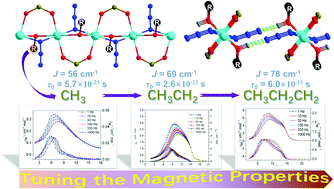当前位置:
X-MOL 学术
›
New J. Chem.
›
论文详情
Our official English website, www.x-mol.net, welcomes your
feedback! (Note: you will need to create a separate account there.)
Solvent coligands fine-tuned the structures and magnetic properties of triple-bridged 1D azido-copper(ii) coordination polymers†
New Journal of Chemistry ( IF 2.7 ) Pub Date : 2018-11-20 00:00:00 , DOI: 10.1039/c8nj04731f Peipei Cen 1, 2, 3, 4, 5 , Weize Yuan 1, 2, 3, 4, 5 , Shuchang Luo 5, 6, 7, 8 , Xiangyu Liu 5, 9, 10, 11, 12 , Gang Xie 1, 2, 3, 4, 5 , Sanping Chen 1, 2, 3, 4, 5
New Journal of Chemistry ( IF 2.7 ) Pub Date : 2018-11-20 00:00:00 , DOI: 10.1039/c8nj04731f Peipei Cen 1, 2, 3, 4, 5 , Weize Yuan 1, 2, 3, 4, 5 , Shuchang Luo 5, 6, 7, 8 , Xiangyu Liu 5, 9, 10, 11, 12 , Gang Xie 1, 2, 3, 4, 5 , Sanping Chen 1, 2, 3, 4, 5
Affiliation

|
Based on different alkanol solvents, a family of azido–copper coordination polymers has been successfully synthesized. The as-synthesized compounds share the formula [Cu(4-tfmba)(N3)(solvent)]n, where 4-tfmba = 4-trifluoromethyl benzoic acid and solvent = CH3OH (1), C2H5OH (2) and C3H7OH (3). Single-crystal structure analysis indicates that the Cu(II) centers in 1–3 are interconnected by an alternant triple-bridge of μ-1,1-azido, syn,syn-carboxy and μ2-alkanols, yielding homoplastically well-isolated 1D metal-chain patterns with tiny disparities in the geometric parameters. Noteworthily, the homologous alkanol solvents with growing carbon chain are not only the reaction solvents but are also employed to be the linkers to embed the structural frameworks of the resulting polymers, regulating in an orderly way the interchain structures and thus fine-tuning the magnetic behaviors of the resulting compounds. As a result, the predominant intrachain ferromagnetic exchanges caused by counter-complementarity of the threefold super-exchange channels are revealed in all three cases, finally giving rise to the ascending magnitudes of magnetic coupling effect (J = 56.21 cm−1 for 1, J = 68.94 cm−1 for 2 and J = 77.94 cm−1 for 3) and the well-organized scenarios of magnetic order and slow relaxation that are infrequent in known azido–Cu(II) coordination networks. Among 1–3, the exchange of CH3OH for C2H5OH or C3H7OH, all of which coordinate through a single O atom, induces an interesting dynamic magnetic transition from a vitreous state to quasi-superparamagnet. Moreover, DFT calculations have been carried out to provide a qualitative and quantitative theoretic explanation of the magnetic behaviors of 1–3.
中文翻译:

溶剂大分子可微调三桥一维叠氮基铜(ii)配位聚合物的结构和磁性†
基于不同的链烷醇溶剂,已成功合成了一系列叠氮基-铜配位聚合物。合成后的化合物具有式[Cu(4-tfmba)(N 3)(溶剂)] n,其中4-tfmba = 4-三氟甲基苯甲酸,溶剂= CH 3 OH(1),C 2 H 5 OH (2)和C 3 H 7 OH(3)。单晶结构分析表明,1-3中的Cu(II)中心通过μ-1,1-叠氮基,syn,syn的交替三桥相互连接-羧基和μ2-链烷醇,产生均聚物塑性良好隔离的一维金属链图案,在几何参数上存在微小差异。值得注意的是,具有增长的碳链的同源链烷醇溶剂不仅是反应溶剂,而且还被用作连接剂,以嵌入所得聚合物的结构框架,以有序的方式调节链间结构,从而微调磁性能。所得化合物。其结果是,主要的链内所造成的三倍超交换通道的反铁磁互补交流揭示在所有三种情况下,最后引起的磁耦合效应的上升幅度(Ĵ =56.21厘米-1为1,Ĵ=68.94厘米-1为2和Ĵ =77.94厘米-1为3),并且是已知的叠氮基的Cu(不频繁的磁有序和慢松弛的组织良好的情形II)配位网络。在1-3中,CH 3 OH与C 2 H 5 OH或C 3 H 7 OH的交换均通过单个O原子进行配位,从而引起从玻璃态到准超顺磁性的有趣的动态磁跃迁。此外,已经进行了DFT计算,以提供定性和定量的理论解释1–3。
更新日期:2018-11-20
中文翻译:

溶剂大分子可微调三桥一维叠氮基铜(ii)配位聚合物的结构和磁性†
基于不同的链烷醇溶剂,已成功合成了一系列叠氮基-铜配位聚合物。合成后的化合物具有式[Cu(4-tfmba)(N 3)(溶剂)] n,其中4-tfmba = 4-三氟甲基苯甲酸,溶剂= CH 3 OH(1),C 2 H 5 OH (2)和C 3 H 7 OH(3)。单晶结构分析表明,1-3中的Cu(II)中心通过μ-1,1-叠氮基,syn,syn的交替三桥相互连接-羧基和μ2-链烷醇,产生均聚物塑性良好隔离的一维金属链图案,在几何参数上存在微小差异。值得注意的是,具有增长的碳链的同源链烷醇溶剂不仅是反应溶剂,而且还被用作连接剂,以嵌入所得聚合物的结构框架,以有序的方式调节链间结构,从而微调磁性能。所得化合物。其结果是,主要的链内所造成的三倍超交换通道的反铁磁互补交流揭示在所有三种情况下,最后引起的磁耦合效应的上升幅度(Ĵ =56.21厘米-1为1,Ĵ=68.94厘米-1为2和Ĵ =77.94厘米-1为3),并且是已知的叠氮基的Cu(不频繁的磁有序和慢松弛的组织良好的情形II)配位网络。在1-3中,CH 3 OH与C 2 H 5 OH或C 3 H 7 OH的交换均通过单个O原子进行配位,从而引起从玻璃态到准超顺磁性的有趣的动态磁跃迁。此外,已经进行了DFT计算,以提供定性和定量的理论解释1–3。











































 京公网安备 11010802027423号
京公网安备 11010802027423号